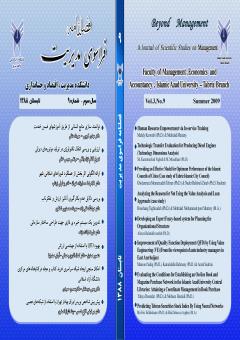تدوین یک سیستم خبره یِ فازی جهت طراحی ساختار سازمانی
الموضوعات : Business Management
1 - استادیار گروه مدیریت،واحد تبریز، دانشگاه آزاد اسلامی ،تبریز،ایران
الکلمات المفتاحية: ساختار سازمانی, تئوری مجموعه های فازی, ابعاد محتوایی, رویکرد اقتضائی, سیستم خبره,
ملخص المقالة :
در این مقاله با فرض قرار دادن رویکرد اقتضائی، سعی شده است، مدلی بر مبنای ریاضیات فازی جهت تعیین ساختار مناسب سازمانی ارائه گردد. مدل معرفی شده پنج مرحله دارد. در مرحله اول یک سیستم فازی طراحی می شود که ورودی های آن را چهار بعد مهمِ محتوائی سازمان و خروجی آن را شکل های مختلف سازمانی معرفی شده توسط مینتزبرگ، تشکیل می دهند. در مرحله دوم ورودی ها و خروجی ها پس از افرازبندی، به اعداد فازی تبدیل می شوند. قوانین استنتاج(موتور استنتاج) در مرحله سوم تبیین می گردند. در مرحله چهارم فازی زدائی انجام می گیرد. در نهایت مدل طراحی شده در مرحله پنجم آزمون می شود.
Arabi, M. (1997). Design of Organizational Structure. Tehran: Cultural Research Bureau, (In Persian).
Daft, R. L. (1998). Theory and Design of Structures. Translated by: A., Parsayian & S. M., Arabi, Tehran: Office of Cultural Research, (In Persian).
Duncan, R. B. (1972). Characteristics of organizational environments and perceived environmental uncertainty. Administrative Science Quarterly, 17.
Englehardt Charles S., & Simmons, P. R. (2002). Organizational flexibility for a changing world. Leadership & Organization Development Journal, 23(5), 113-121.
Hall, R. H. (1997). Organization: Structure, Process and References. Translated by: A., Parsaeean, & S. M., Arabi, Tehran: Office of Cultural Research, (In Persian).
Kimberly, J. R. (1976). Organizational Size and the Structuralist Perspective: A Review, Critique, and proposal. Administrative Science quarterly.
Lysonski, S. (1985). A boundary theory investigation of the product manager′s role. Journal of Marketing, 49.
Lysonski, S., Levas, M., & Lavenka, N. (1995). Environmental uncertainty and organizational structure: a product management perspective. Journal of Product & Brand Management, 4(3).
Martinsons, A. G. B., & Martinsons, G. (1994). In search of structural excellence. Leadership & Organization Development Journal, 15(2).
Miles, R. E., & Snow, C. C. (1986). Network organizations: new concepts for new forms. California Management Review, 28(3).
Mintzberg, H. (1995). Organization: Five Working Patterns. Translated by: A., Faghihi, & H., Vaziri Sabeghi, Tehran: Government Education Management Center, (In Persian).
Mintzberg, H. (1979). The structuring of organizations, Enghewood Cliffs. N.J.: Perntice-Hall.
Nadled, D., & Tushman, M. (1997). Competition by Design. Norcros: Oxford University Press.
Pugh, D. S., Hickson, D. J., Hinings, C. R., & Turner,C. (1969). The Context of Organization Structures. Adminstrative science quarterly.
Robbins, S.P. (1990). Organization Theory: Structure. Prentice Hall: Design and Application.
Robbins, S. P. (1999). Organization Theory (Structure, Design, Applications)., Translated by: S. M., Alvani & H., Danaeefard, Tehran: Saffar Publishing House, (In Persian).
Stoner, J., & Freeman, E. (1996). Institute of Business Studies and Research, (In Persian).
Wagner, B., & Digman, L. (1997). The relationship between generic and time-based strategies and performance. Journal of Managerial Issues, 9(3).
_||_
Arabi, M. (1997). Design of Organizational Structure. Tehran: Cultural Research Bureau, (In Persian).
Daft, R. L. (1998). Theory and Design of Structures. Translated by: A., Parsayian & S. M., Arabi, Tehran: Office of Cultural Research, (In Persian).
Duncan, R. B. (1972). Characteristics of organizational environments and perceived environmental uncertainty. Administrative Science Quarterly, 17.
Englehardt Charles S., & Simmons, P. R. (2002). Organizational flexibility for a changing world. Leadership & Organization Development Journal, 23(5), 113-121.
Hall, R. H. (1997). Organization: Structure, Process and References. Translated by: A., Parsaeean, & S. M., Arabi, Tehran: Office of Cultural Research, (In Persian).
Kimberly, J. R. (1976). Organizational Size and the Structuralist Perspective: A Review, Critique, and proposal. Administrative Science quarterly.
Lysonski, S. (1985). A boundary theory investigation of the product manager′s role. Journal of Marketing, 49.
Lysonski, S., Levas, M., & Lavenka, N. (1995). Environmental uncertainty and organizational structure: a product management perspective. Journal of Product & Brand Management, 4(3).
Martinsons, A. G. B., & Martinsons, G. (1994). In search of structural excellence. Leadership & Organization Development Journal, 15(2).
Miles, R. E., & Snow, C. C. (1986). Network organizations: new concepts for new forms. California Management Review, 28(3).
Mintzberg, H. (1995). Organization: Five Working Patterns. Translated by: A., Faghihi, & H., Vaziri Sabeghi, Tehran: Government Education Management Center, (In Persian).
Mintzberg, H. (1979). The structuring of organizations, Enghewood Cliffs. N.J.: Perntice-Hall.
Nadled, D., & Tushman, M. (1997). Competition by Design. Norcros: Oxford University Press.
Pugh, D. S., Hickson, D. J., Hinings, C. R., & Turner,C. (1969). The Context of Organization Structures. Adminstrative science quarterly.
Robbins, S.P. (1990). Organization Theory: Structure. Prentice Hall: Design and Application.
Robbins, S. P. (1999). Organization Theory (Structure, Design, Applications)., Translated by: S. M., Alvani & H., Danaeefard, Tehran: Saffar Publishing House, (In Persian).
Stoner, J., & Freeman, E. (1996). Institute of Business Studies and Research, (In Persian).
Wagner, B., & Digman, L. (1997). The relationship between generic and time-based strategies and performance. Journal of Managerial Issues, 9(3).


